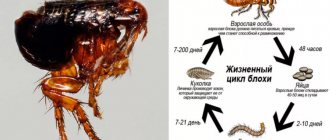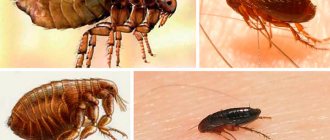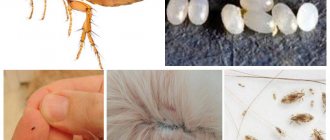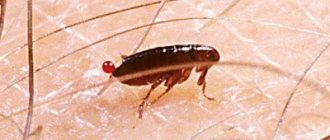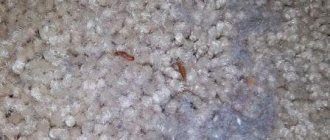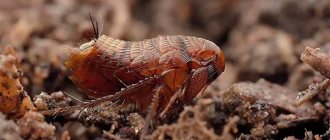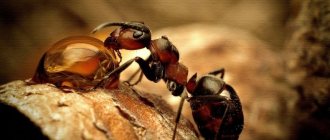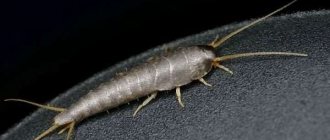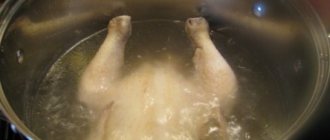Today, approximately 500 specific species of fleas live in the Russian Federation. The most common of them are those insects that live on pets (cats, dogs - Ctenocephalides canis, Ctenocephalides felis, etc.), as well as on rats or humans (for example, Pulex irritans).
About 30 species of these small pests live in private households or apartments. The size of 1 insect is 1–5 mm.
Most people do not know how the different types of fleas reproduce. This and other nuances are discussed in detail below in this article.
How fleas are fertilized and reproduce
How are fleas fertilized and reproduce? They have a specific reproductive system.
Mating of similar insects Pulex irritans, Ctenocephalides felis, Ctenocephalides canis or Xenopsylla cheopis lasts a maximum of 10 hours. They almost always copulate with each other after they have drunk a large amount of blood from a particular host.
What is the reproduction rate of various flea species (Pulex irritans, Ctenocephalides canis, Xenopsylla cheopis, etc.)? After mating with the male, the female flea begins to lay eggs. Then she puts away up to 10 pieces at a time.
The total number of flea eggs from 1 female is more than 500 pieces per 1 life cycle. Such small pests copulate with each other in comfortable conditions.
Females breed in dust, on various rags, certain woolen products, genital crevices, dog kennels, clothes or other places hidden from prying eyes.
Flea eggs are covered with a white shell and also have an oval shape. They are similar to grains of rice, but are significantly smaller in size.
Flea reproduction
Once the flea emerges from the cocoon, it can reproduce. All types of fleas reproduce the same way. Mating can occur both on the body of the breadwinner and outside it.
Fleas have genitals:
- in the female - ovaries, uterus and spermatic receptacle,
- the male has two testes and a genital claw.
The female climbs onto the male's back and takes the genital claw into the spermatheca. The process can take from 30 minutes to 2 hours. Immediately after copulation, the female needs to feed on blood.
The male participates in reproduction once - this is enough for the female to give birth to offspring for the rest of her life, which is at least 400 eggs.
Fleas do not lay eggs in special places, but shoot them out of the abdomen under pressure, thereby expanding the area of distribution. The eggs are not covered with adhesive substances, so they roll freely over the fur and skin without getting stuck anywhere.
Flea lifespan
How long does the most common human flea, Pulex irritans, live? In a favorable environment, this insect lives for about 3 months.
During this period, 1 female of this bloodsucker lays 400–600 small eggs, and each such small pest makes about 100 bites. Only after this minimal “plan” is completed does this parasite die naturally.
An important condition for comfortable living of fleas is compliance with specific air humidity and temperature. Thus, rat-like insects Xenopsylla cheopis live quietly inside any room at 14 degrees Celsius and 55% humidity or more.
Bloodsuckers that live in a private household or apartment (Pulex irritans, Ctenocephalides felis or Ctenocephalides canis) also feel good there. However, they die quickly without immediate access to blood.
If these insects live in places with elevated temperatures, then all their phases of reproduction and development pass much faster. Thus, adults become very large.
Typically, flea larvae of pulex irritans degenerate into an adult in 30 days, while at elevated temperatures the fleas multiply and then grow much faster - in 7 days. The development of flea eggs ends after 14 days, and then for another 14 days this small pest is in the pupal phase.
These bloodsuckers, who live not in a warm home, but in nature, die quickly. After all, they are destroyed by the carriers themselves (dogs, cats, etc.). Then the animals bite the bloodsuckers out of their fur.
Also, many such bloodsuckers die from various infections. There are fleas that change several hosts during their life when the animal dies.
Fleas Ctenocephalides felis, Ctenocephalides canis immediately leave a dead dog or cat because they cannot feed on the blood of a dead animal.
How long do these insects live?
How long do various species of bloodsuckers live (for example, Pulex irritans, Ctenocephalides felis, Ctenocephalides canis, Xenopsylla cheopis, etc.)?
The lifespan of all types of fleas is directly related to these 3 factors:
- specific temperature regime;
- living conditions - apartment or street;
- air humidity.
On average, these small pests live 18–90 days. Throughout its life, 1 bloodsucker makes about 10 bites and, thus, it injures its owner.
Over the course of her entire life, a female flea lays about 500 eggs.
However, these bloodsuckers often die from various infections that they themselves spread, as well as from the teeth of a domestic cat or dog, from human hands or any disinfectant.
Can parasites live without food?
How long do fleas live without food? Approximately 2–3 months. the parasites Pulex irritans, Ctenocephalides felis, Ctenocephalides canis or Xenopsylla cheopis can live without consuming blood.
Especially those individuals that often bite humans. At the same time, they remain mobile.
However, if these insects do not feed for a long time, they do not reproduce in any way. After all, only after a hearty lunch do they mate with each other, and then the female flea lays many small eggs.
Do these bloodsuckers live in a private household or apartment if there are no animals or people there? Yes, but not indefinitely. Sooner or later they still die.
What determines the lifespan of a flea?
At the moment, it is the sharp change in air temperature that greatly affects the lifespan of fleas.
In addition to it, the lifespan of such bloodsuckers Pulex irritans, Ctenocephalides felis, Ctenocephalides canis or Xenopsylla cheopis is directly related to the following factors:
- air humidity. Low (but not too low) humidity is comfortable for bloodsuckers;
- source of food. Small pests that do not receive fresh animal or human blood for a long time live longer;
- the invariability of specific temperature and humidity conditions.
Bloodsuckers that live in areas with constant sharp changes in humidity and fluctuations in street temperature often quickly become numb. This significantly increases the life span of a flea.
An important factor for fleas is the number of offspring produced from 1 female, and not the rate of formation of flea larvae. As a rule, such a process is continuous.
Thus, while fighting various bloodsuckers, the lodger not only removes these parasites from the pet’s fur, but also destroys flea larvae hidden in secluded places.
Fighting methods
To kill fleas, folk remedies and professional preparations are used. It all depends on the degree of infection of the room or animal.
Methods for destroying eggs and larvae
Destruction of eggs
To exterminate the flea population, temperature is used. You can kill eggs by freezing them or washing them at high temperatures. Flea eggs are not afraid of the action of insecticides. Pests are destroyed immediately after they are born. Since the larvae do not have time to complete the full development cycle, the parasite population dies.
On a note!
It is necessary to wash your pet's rug at a high temperature, or take it out into the cold, dry it thoroughly, and leave it for two days. You can sprinkle snow on top to increase efficiency.
Fighting larvae
You can get rid of it with powder or dust. In places of detection or probable accumulation, sprinkle paths with boric acid, treat the surface with Mashenka chalk and Clean House dust. The poison enters the body through contact. The destruction of parasites occurs in 10 days. The poison remains active on the surface for about 2 months.
Habitats of bloodsuckers in the apartment and in nature
Where do fleas live?
In an apartment, the parasites Pulex irritans, Ctenocephalides felis or Ctenocephalides canis settle and live for a long time in the following places:
- in bedding for domestic cats, dogs or other pets;
- on carpeted surfaces. Then flea eggs accumulate on the carpets;
- on sofa upholstery and outer covering of chairs;
- on a variety of soft toys for children;
- on old clothes;
- on mattresses;
- in bed linen;
- behind room or other apartment skirting boards;
- under the linoleum.
Outdoors, these small pests live close to a variety of animals (hamsters, rabbits, rats, etc.), which provide them with a source of food.
Fleas infest and lay their eggs and larvae in trash cans, basements, sand piles, bird nests, or inside the burrows of various animals.
Household fleas that live near people are divided into the following types of insects:
- bloodsuckers from pets - Ctenocephalides felis and Ctenocephalides canis;
- rat or mouse parasites - Xenopsylla cheopis, etc.;
- ground or basement bloodsuckers - for example, Vermipsylla alakurt;
- bed insects, etc.
Such bloodsuckers are small insects that cause a lot of problems for animals or humans. Their bites are very painful, after which itching and skin irritation form on the fur of a cat or dog, as well as on human skin.
In addition, the bloodsuckers Pulex irritans, Ctenocephalides felis or Ctenocephalides canis carry many unpleasant ailments. Therefore, it is important for a person to get rid of them in a timely manner - to destroy not only the fur of pets, but also to remove them from open or hidden corners of the apartment.
Can small pests live on the sofa and on clothes?
At home, the most common human flea, Pulex irritans, often lives on sofas, carpets, clothing or bedding. They also live behind room and other baseboards, as well as in wall cracks.
These small pests Pulex irritans like to live in comfortable conditions.
These bloodsuckers love to live and copulate on the warm carpet pile, where they sit out after satiation.
In ancient times, rich people made such anti-flea traps: they hung small pieces of natural concrete wool on their bare legs to lure bloodsuckers Pulex irritans, Ctenocephalides felis or Ctenocephalides canis, and then burned them.
Can bloodsuckers live on the body and on human hair?
Unlike various lice, human fleas Pulex irritans, which are infested in a private house or apartment, do not live on the skin or hair for a long time. After all, after being saturated with human blood, they immediately leave the human body.
If the bloodsucker is distracted while eating, it lingers for some time on the clothing on the underside.
Sometimes these small pests remain on summer or other clothing for 1–2 days. Then the Pulex irritans fleas periodically bite the person. However, they do not use humans as their daily hosts because little hair grows on them.
Laboratory studies by biologists have shown that bloodsuckers Pulex irritans live and reproduce quietly after consuming human blood. But more often, these small pests rarely attack people, and also do not copulate on their body.
The fact is that these insects are immediately very noticeable on human skin, and people immediately shake them off. In addition, it is difficult for them to move around a person, because their bristly small body is adapted to a comfortable life only on thick animal fur.
Human fleas, Pulex irritans, do not typically lay multiple eggs in hair. Firstly, these small pests often simply do not reach the head - they jump at most to ankle level.
And secondly, when they come into contact with a person, such bloodsuckers immediately bite him, and then immediately get out of the way.
How to determine the presence of parasites in animals
All cat owners know what an adult cat looks like. Because they appear in the warm season after street walks. The presence of parasites can be determined by the following signs:
- cats are constantly itching, trying to pick something out with their teeth;
- become restless, sleep poorly, nervously move their mustache in their sleep;
- stop eating and drink a lot;
- the wool loses elasticity and shine, becomes dull, and in long-haired breeds lumps are found;
- behavior changes: attention decreases, anxiety appears;
- abrasions, scratches and spots from bites appear on the skin.
When examining the fur, white dandruff - eggs - is discovered. And small black insects that move quickly under the cover of fur.
Some owners can let things take their course. With the onset of cold weather, the parasites themselves will disappear. However, in this case, the animal will constantly suffer and there will be a threat to the owner himself in the event of rapid reproduction.
How bloodsuckers get into an apartment
Will fleas live in the apartment in winter or not? Most likely not, because they are more likely to start in residential areas in the summer or autumn. At the same time, they often inhabit the lower floors of apartment buildings or private households.
Ground-like insects inhabit very dusty rooms or abandoned various buildings.
The fleas Pulex irritans, Ctenocephalides felis or Ctenocephalides canis enter an apartment or private house in this way:
- from the entrance of an apartment building;
- enter the home from neighbors;
- they are brought in by domestic animals;
- They infect a certain home with various rodents.
If the basement is always damp, then flea breeding often begins in this place. After all, the most common human flea, Pulex irritans, loves dampness. Also, these small pests multiply quickly inside well-heated living spaces.
If a person does not ventilate his apartment for a long time, and there is always a lot of garbage in it and sunlight does not enter inside, then the bloodsuckers Pulex irritans quickly infest and multiply in this home.
Due to their small size, these parasites enter the home through small cracks in the apartment.
In addition, various species of fleas (for example, Ctenocephalides canis, etc.) do not always live on their host. They live comfortably on baseboards, floor crevices, linoleum, carpet, as well as on pieces of furniture, clothing or a variety of soft toys.
Video
Flea infestations of your pet and home
What does an adult look like?
Features of the appearance of parasites living on cats are:
- a durable shell of a small body covered with small bristles;
- ctenidia, or paddles, are located on the chest and head;
- fleas use antennae-shaped antennae to search for food and explore the territory;
- insects have three pairs of legs, the hind ones of which are the longest and are designed for pushing before jumping;
- the mouth is a kind of piercing and at the same time sucking apparatus;
- Behind the parasite there is a special organ that detects the slightest vibrations in the air, detecting danger.
- if the air temperature in the apartment is not higher than +37 degrees, and the humidity reaches 60%, then insects that settle on pets or indoors will live up to two months;
- at lower air temperatures, parasites can live up to one and a half years.
This structure of fleas allows them to jump on cats, dogs, furniture in the house, clothes, etc. Thanks to the bristles on the body , insects easily move between the fur, down, feathers, folds of animals and birds.
The lifespan of this type of parasite depends on the conditions in which they live:
Why are these bloodsuckers needed?
At the moment, there are many species of fleas (Pulex irritans, Ctenocephalides felis, Ctenocephalides canis, Xenopsylla cheopis, etc.). Without these small pests, many animals would simply die out.
After all, these bloodsuckers are part of the specific food chain of various animals. Also, these bloodsuckers transfer various diseases from one carrier to another.
Thus, blood-sucking insects (fleas) are useful not for people, but for certain viral microorganisms.
The role of such a bloodsucker in nature comes down to the fact that it is a parasite. Thus, this insect shortens the life of its “carrier” (cat, dog, etc.).
In general, fleas have a positive meaning in nature, but they are more likely an epidemic. Often these small pests are the causative agents and first carriers of various epidemiological infections.
According to numerous laboratory studies by biologists, this bloodsucker simultaneously carries 30 types of specific viruses and bacteria.
Fortunately, not all such insects have the same ability to transmit various pathogens (plague, typhoid, etc.). It all depends on the diet, type and physical condition of the bloodsucker.
What diseases do fleas carry?
All types of fleas can be carriers of infectious diseases.
The most common infections include:
- plague;
- yersinosis;
- pseudotuberculosis;
- typhus;
- salmonellosis;
- tularemia.
Pathogens enter the human bloodstream through saliva when bitten. The rat flea is the most common carrier of infection, as it parasitizes rats, which spread diseases.
Life cycle of a flea
On average, fleas Pulex irritans, Ctenocephalides felis, Ctenocephalides canis, Xenopsylla cheopis or other types of similar bloodsuckers live 1-1.5 years. Moreover, they remain in the pupal stage for a very long time - under not the most favorable temperature conditions, bloodsuckers remain in this state for several months.
Even when this small pest becomes an adult and enters the adult stage, it continues to live in its small cocoon and waits for a specific moment for further hatching.
The life span of a flea directly depends on their type and size of the flea, food and living conditions in the natural or other environment. Most often, such bloodsuckers live for about 6 months. During this time, this small pest bites its “carrier” more than 200 times.
The life cycle of a human or other flea consists of 4 stages of development:
- the birth of a bloodsucker in an egg;
- the appearance of flea larvae;
- transformation of an insect into a pupa;
- hatching from the pupa into an adult flea - “imago”.
These small pests, like certain other parasites, also go through the 2nd above-mentioned stage of development of a cat or other flea - the appearance of a larva.
What do the larvae of these bloodsuckers look like? The flea larva has sharp small jaws that gnaw the egg from the inside.
Larvae of small pests Pulex irritans die due to the following factors:
- low or high air temperature - about -50 or above +40 degrees Celsius, respectively;
- constant exposure to water;
- daily exposure to direct sunlight.
Features of the life of parasites
Fleas are unique creatures with a high survival rate. Insects are not picky about environmental conditions, hardy, and jump well in height and length. They live in dark, secluded places.
The optimal condition for existence is a temperature range from 20 to 30 degrees Celsius, humidity – within 60%. In such conditions, the renewal of offspring occurs every 20 days.
Interesting!
An adult can starve for more than 2 months, but in this state does not lay eggs. Flea pupae can easily tolerate temperatures of -10 degrees Celsius. At a temperature of about 28 degrees Celsius, the larvae emerge from the egg after 2 days.
The behavior, feeding habits, and living conditions of larvae and adults differ significantly. They live in different places and have different taste preferences. This situation provides high survival rates for parasites.
What fleas eat depends on the stage of development. For adult individuals, the source of nutrition is animal blood; in special situations, they bite humans. The larvae feed on food waste, rot, particles of epidermis, and feces.
What do parasites eat?
What do the fleas Pulex irritans, Ctenocephalides felis, Xenopsylla cheopis and other species of these insects eat every day? These small pests have a small mouth proboscis through which they drink blood from a particular animal or person.
Compared to many other bloodsuckers, for these insects blood proteins are the main food.
Both females and males are parasites. After puncturing the skin, the bloodsucker releases special specific substances that simultaneously stop blood clotting and activate blood flow.
Blood addiction threshold
When eating the blood of their “carrier” (cat, dog, etc.), at a certain point in time, fleas pass a specific point, after which they then need blood every day. This is similar to a person becoming addicted to drugs or alcohol.
How long do fleas live without blood? Removed from an infected cat or dog and after 5 days of feeding, male fleas quickly die after 48 hours, and females - 96 hours.
Such bloodsuckers live 14 days after leaving their owner, if the initial feeding time was 12 hours. After all, then the threshold for flea dependence on blood is not reached.
Preventive measures
Home remedy for fleas.
Following simple recommendations will help prevent fleas from appearing in your home:
- wash domestic dogs and cats with a special shampoo and use preventive means to combat parasites;
- when visiting the forest, wear clothes that cover exposed areas of the body as much as possible;
- avoid contact with street animals;
- regularly clean the room with a vacuum cleaner of soft surfaces;
- wash clothes in hot water and store them only after they are completely dry;
It is also recommended to regularly remove debris from basements.
Briefly about the anatomical process of mating in fleas
The continuation of the genus of ectoparasites always depends on the female, since fleas reproduce by laying eggs. The features of this biological process can be explained by the physiological structure of the insect’s body.
Male fleas have two testes, at the end of each of which there is a reproductive claw - it is from this that the seed comes out when the female is fertilized. The female individual has a more complex structure of the reproductive system. Together with the ovaries, which are located in place of the uterine cavity, there are oviducts.
Mating takes a lot of time. It takes several hours for fertilization to occur. In this case, the contact between the female and the male lasts about 15-20 minutes - during this time the female climbs onto the partner’s back and absorbs seminal fluid from his genital claw.
Adult fleas have a rather unusual appearance: their body is flattened laterally, and its length can vary, depending on the type of parasite. Cat fleas grow up to 4-5 mm, and males can be much smaller than females. After feeding, the size of the fertilized female can reach 1 cm.
Comprehensive measures
To get rid of annoying insects efficiently, you need to be very careful and careful. There are a huge number of means - from modern to traditional methods. The most important thing is your desire to get rid of annoying pests. To remove fleas you need:
- Carefully inspect and treat with insecticide all surfaces of the house or apartment, bowls and places where animals sleep;
- Keep animals and children away from treated areas;
- In addition to all places in the house, treat the animal with a special product;
- Carry out weekly wet cleaning;
- Repeat the flea extermination procedure several times.
It is worth noting that the larvae are not direct pests. Despite this, it is necessary to get rid of them in order to avoid the appearance of adult individuals. They can be destroyed with the same drugs that are used to poison fleas. Larvae are even more difficult to remove than adult fleas, and you need to be especially careful and thorough in this matter. There is no reason to try to remove larvae using natural means that can scare them away at most. These include thyme, wormwood and eucalyptus. The insects will simply develop resistance, and all efforts will be in vain.
It is necessary not only to get rid of fleas, but also to subsequently maintain the premises in a condition in which they will not attract them. To do this, it is worth maintaining cleanliness and order, purchasing flea collars for animals that spend time outside, and constantly monitoring the condition of rugs and bedding.
Stages of transformation of a flea into an adult insect
The offspring produced by the female will go through several stages of development before they become sexually mature and ready for reproduction. Ectoparasites that live in the fur of domestic animals go through the following cycle of several stages:
- egg stage;
- larval stage;
- pupal stage;
- imago.
From a biological point of view, the most difficult stage is the transformation from an egg into a viable larva. For the development of an insect, appropriate conditions are required. They can be called ideal if parasites develop in the fur of warm-blooded mammals.
